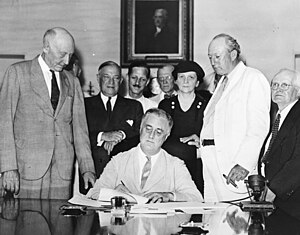This year’s 2% payroll tax cut was paid for by increased deficit spending. In other words we “temporarily” turned Social Security from a self-funded program into a Congressional budget allocation funded by more debt. That is exactly the opposite of the original design of the program. On this path Social Security becomes another form of welfare subject to the political whim of each new Congress . . . but it’s only temporary. When you look on your paystub you will see “FICA” opposite the deduction for this tax. Do you know what the I stands for? It stands for Insurance, the Federal Insurance Contributions Act. Messing with something that is supposed to be insurance funded by employer and employee contributions is nuts. It undermines the very essence of the Social Security system for political expediency and places its funding not with the beneficiaries, but at the mercy of Congress.
Some ideas to pay for extending and enlarging this tax break, and I use the term loosely, include raising airport fees, gasoline taxes or taxes on other parts of the economy. Even someone like me who got a C in Econ 101 can see the irony of this; raise the cost of gasoline… that should help the middle class.
The many promises for this 2% tax break; new consumer spending, job growth, etc., we’re so successful politicians want to do it again also on a “temporary” basis. This time they want to raise the success level by cutting the tax rate to 3.1%, fully half the worker portion of 6.2% needed to fund Social Security (well, more is actually needed but that’s another story). This time they are actually going to pay for it by increasing taxes someplace or cutting spending someplace else thereby allowing some other federal money to be transferred to Social Security where it can be used to buy Treasury bonds to fund ongoing deficit spending, just like the payroll tax.
Given this is all “temporary” (like the estate tax in 1918) what’s the big deal? The big deal is what happens at the end of 2012? Will the middle class be able to withstand a 3.1% tax “increase” then better than a 2% “increase” now? Has the average beneficiary of this entire stimulus absorbed the 2% into their standard of living? Have they incurred new debt based on their new-found ability to repay?
To date we have sent stimulus checks to most Americans, we lowered their out-of-pocket health care costs, gave them tax credits to buy a car, a house, put in central air, new windows and I lost track of what else, now at the end of 2011 we are told diverting another $550 a year from Social Security to lower the average family tax bill will do the trick.
These tax games may be temporary, but it appears common sense is gone forever.






Recent Comments